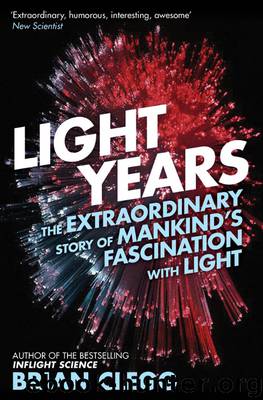Light Years by Brian Clegg

Author:Brian Clegg
Language: eng
Format: epub
Publisher: Icon Books Ltd
Such bioluminescence is the result a reaction that turns chemical energy into light, blasting photons from the electrons around the molecules of complex chemicals. It is practically a reversal of the process that provides the oxygen for our air and keeps most plant life flourishing – photosynthesis. The first hint of this natural life-support mechanism was discovered by Joseph Priestley, a Yorkshire-born minister in the Dissenting Church. By the mid-1770s, Priestley was finding it difficult to apply himself to both his ministry and the scientific investigations that had interested him since his college days. He took the opportunity of working for William Petty Fitzmaurice, the second Earl of Shelburne. Shelburne wanted a librarian, but more than that, a man with a sharp intelligence with whom he could discuss literary matters. In return for his company, Shelburne was happy to support Priestley’s scientific work.
While with the Earl, Priestley spent much of his time investigating the nature of air. In fact he succeeded in separating off oxygen, though he didn’t recognize it as such. Priestley supported the popular theory of the time that there was a component of matter called phlogiston that made it flammable. One of his experiments involved putting a candle under a sealed bell jar. The candle would burn out long before it ran out of wax – Priestley believed the phlogiston was being exhausted. He also discovered that a mouse could equally ‘injure’ the air. Luckily for at least some mice, he found that it was possible to restore the injured air and the mouse by putting a plant under the jar.
Priestley never got any further with photosynthesis, though he made other chemical discoveries and continued to have a stormy life which itself seemed imbued with more than the usual level of the imaginary phlogiston. Not only was one of his books, A History of the Corruptions of Christianity officially burned, but his house was torched by angry mobs when he openly supported the French Revolution. Priestley, who had long since left the Earl of Shelburne over religious differences, emigrated to the United States, where his revolutionary inclinations would be more appreciated.
Only four years after Priestley’s discovery, Dutch court physician Jan Ingenhousz managed to take one step further. Ingenhousz, by then living and working in England, repeated Priestley’s experiments, linking the plant’s ability to recover the mouse to the energy of the Sun. Unfortunate mice that were put through the experiment in the dark never recovered. It was only when the plant was in sunlight that the mice came back to life.
The final parts of the international effort to understand photosynthesis went to French pastor Jean Senebier and Swiss scientist Theodore de Saussure. Around 20 years after Ingenhousz’s work, in 1796, they showed that Priestley’s injured air was in fact carbon dioxide, and that plants under the stimulus of light took in carbon dioxide and water to produce oxygen and biochemical carbon chains. Only a tiny part of the Sun’s light hitting the Earth – less than one per cent – is used up in photosynthesis, but this powers the whole living structure of the planet.
Download
This site does not store any files on its server. We only index and link to content provided by other sites. Please contact the content providers to delete copyright contents if any and email us, we'll remove relevant links or contents immediately.
The Complete Stick Figure Physics Tutorials by Allen Sarah(7135)
Secrets of Antigravity Propulsion: Tesla, UFOs, and Classified Aerospace Technology by Ph.D. Paul A. Laviolette(4974)
Thing Explainer by Randall Munroe(3782)
The River of Consciousness by Oliver Sacks(3412)
The Order of Time by Carlo Rovelli(3072)
How To by Randall Munroe(2911)
I Live in the Future & Here's How It Works by Nick Bilton(2839)
A Brief History of Time by Stephen Hawking(2819)
What If?: Serious Scientific Answers to Absurd Hypothetical Questions by Randall Munroe(2542)
The Great Unknown by Marcus du Sautoy(2532)
Midnight in Chernobyl by Adam Higginbotham(2385)
Blockchain: Ultimate Step By Step Guide To Understanding Blockchain Technology, Bitcoin Creation, and the future of Money (Novice to Expert) by Keizer Söze(2379)
Networks: An Introduction by Newman Mark(2264)
The Meaning of it All by Richard Feynman(2213)
Easy Electronics by Charles Platt(2204)
The Tao of Physics by Fritjof Capra(2162)
Midnight in Chernobyl: The Untold Story of the World's Greatest Nuclear Disaster by Adam Higginbotham(2074)
When by Daniel H Pink(2020)
Introducing Relativity by Bruce Bassett(2017)
